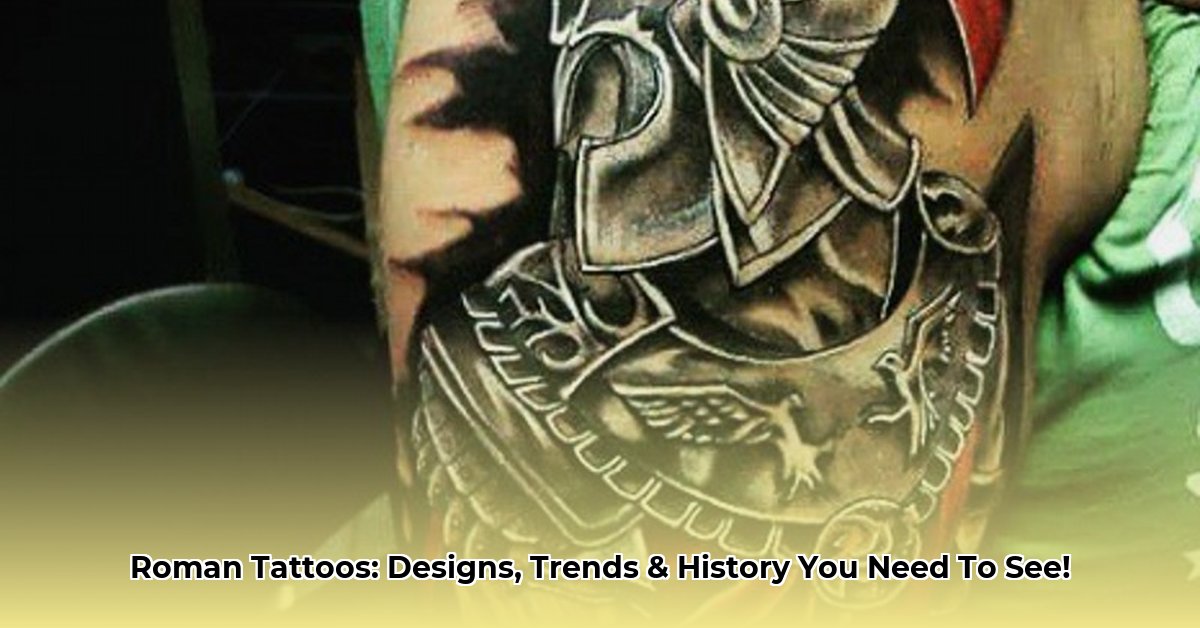Ever picture a Roman with a tattoo? The immediate image for many might be of a person marked as property or punished for their crimes. While this grim reality was undeniably part of ancient Roman life, the complete story of tattoos in the Roman world is far more intricate and compelling than commonly believed. Beyond mere branding, could tattoos have signified military allegiance, preserved cultural identity among conquered peoples, or even served as rudimentary forms of ancient medicine? Today, this ancient practice inspires a surge of modern body art, from fierce gladiators to profound Latin phrases. This comprehensive guide will delve into the historical nuances of Roman tattooing, exploring documented uses, speculative theories, and the enduring appeal that shapes contemporary tattoo trends, all while emphasizing the importance of informed and respectful choices. Learn more about soldier tattoos by reading this resource. Get ready to challenge your preconceived notions about ink in the Roman Empire.
The Somber Truth: Tattoos of Control and Punishment
The most well-documented use of tattoos in ancient Rome points to a stark reality of social control and subjugation. The Romans, much like the Greeks and Persians before them, employed permanent markings, known as stigmata, to manage and identify individuals within their rigid social hierarchy.
Tattoos as a Mark of Slavery: Enslaved people were frequently tattooed, marking them as property. These indelible signs were designed not only to deter escape but also to publicly announce their enslaved status, making reintegration into free society virtually impossible. Common markings might include the master’s name, an abbreviation like “FUG” (for fugitivus, meaning “runaway”), or a symbol denoting ownership. This practice reinforced the dehumanizing aspect of Roman slavery, reducing individuals to mere commodities. The historian Herodian recounted instances of slaves having their foreheads tattooed to prevent desertion.
Branding Criminals for Public Shame: Similarly, criminals, particularly those who committed serious offenses or were deemed incorrigible, could be tattooed as a form of public punishment. These marks served as a permanent advertisement of their crimes, ensuring social ostracism and humiliation. Such branding could denote specific offenses, profoundly impacting their social standing and access to legitimate livelihoods. This visible display of shame was a powerful deterrent and a constant reminder of their transgressions, reflecting the Roman legal system’s emphasis on public degradation as a form of justice.
The Legion’s Mark: Military Identity and Unwavering Loyalty
The question of whether Roman soldiers sported tattoos is a subject of ongoing historical debate, yet compelling circumstantial evidence suggests the practice was indeed present, albeit for pragmatic reasons rather than personal expression.
Identification and Desertion Prevention: For legionaries, a permanent mark could have served as an invaluable identifier, crucial for maintaining discipline and preventing desertion within the vast and mobile Roman army. Accounts from Roman writers like Vegetius mention soldiers being marked, though the term used, stigma, could refer to both tattoos and brands. It is widely believed that Roman soldiers, especially those serving for extended periods, received tattoos, often on their hands or forearms, bearing symbols like “SPQR” (Senatus Populusque Romanus – “The Senate and People of Rome”), the name or emblem of their legion, or the symbol of the emperor. This permanent service record on their skin would have made it incredibly difficult to desert and blend into the civilian population unnoticed.
A Symbol of Belonging and Unification: Beyond mere identification, military tattoos would have fostered a profound sense of camaraderie and shared identity among legionaries. In a multi-ethnic army, a common mark visually reinforced allegiance to Rome and the legion, binding soldiers together in a collective purpose. Imagine a seasoned centurion, his arm bearing the eagle of Rome, symbolizing the might and enduring spirit of the empire he served. This was not a fashion statement, but a mark of commitment, discipline, and the unbreakable bond of military service. While direct archaeological evidence is scarce due to the perishable nature of skin, historical texts and comparative studies with other ancient armies (like those in Egypt or Persia, which also marked their soldiers) lend strong credence to the theory of widespread military tattooing in Rome.
Beyond the Obvious: Cultural Expression and Healing Theories
If tattoos weren’t solely for controlling the subjugated or marking soldiers, what other purposes might they have served in a society as vast and diverse as the Roman Empire?
Expressions of Cultural Identity and Resistance: The Roman Empire encompassed myriad cultures, many of which had their own long-standing traditions of tattooing for religious, spiritual, or tribal purposes. Peoples like the Picts in Britannia, the Thracians, and various Germanic tribes, were renowned for their elaborate body art. When these cultures were brought under Roman rule, did they abandon their practices? It is plausible that tattoos became a subtle, yet powerful, way to preserve and express cultural identity in the face of Romanization—a silent act of defiance, a visible connection to ancestral heritage that Rome could conquer but not erase. While concrete evidence illustrating Romans adopting these for expressions of personal identity is rare, the interactions between cultures would have made them aware of such practices.
Rudimentary Medical or Apotropaic Uses: A fascinating, albeit speculative, area of inquiry concerns the potential for rudimentary medical or protective uses of tattoos. Ancient civilizations, such as the Egyptians and even prehistoric cultures like that of Ötzi the Iceman (dating back to between 3370 and 3100 BCE), show evidence of tattoos possibly applied for therapeutic reasons, often on points correlating with acupuncture meridians. Could the Romans, with their advanced medical knowledge, have adopted similar practices? Perhaps certain symbols or patterns were believed to possess healing powers, ward off illness, or protect against evil spirits, etched onto the skin as a permanent charm or treatment. This hypothesis opens up intriguing avenues for understanding the broader spectrum of body modification in antiquity, suggesting that not all marks were borne of shame or duty.
The Enduring Legacy: Roman Tattoos in the Modern Era
Despite the historical complexities and uncertainties, the allure of ancient Rome remains undiminished. Today, Roman-themed tattoos are experiencing a significant surge in popularity, captivating enthusiasts worldwide. People are drawn to the powerful symbolism, historical depth, and aesthetic grandeur that the Roman world offers, transforming ancient motifs into contemporary body art.
This modern fascination transcends a mere appreciation for history; it’s a way for individuals to embody ideals such as strength, wisdom, courage, and resilience. From the stoicism of emperors to the might of gladiators, Roman iconography provides a rich tapestry of meaning for personal expression.
Iconic Roman Tattoo Designs and Their Historical Roots
The wealth of Roman history, mythology, and art offers an unparalleled source of inspiration for modern tattoo designs. Understanding their historical context enhances their significance and ensures respectful representation.
-
Roman Gods and Goddesses:
- Jupiter (Zeus): King of the gods, symbolizing power, authority, and divine protection. Often depicted with an eagle or thunderbolt.
- Mars (Ares): God of war, representing strength, courage, and assertiveness. Commonly shown in armor with a spear and shield.
- Venus (Aphrodite): Goddess of love, beauty, and fertility. Often adorned with roses, doves, or seashells, embodying grace and passion.
- Minerva (Athena): Goddess of wisdom, strategy, and arts. Represented by an owl, armor, or an olive branch, symbolizing intellect and strategic prowess.
- Neptune (Poseidon): God of the sea, earthquakes, and horses. Typically shown with a trident, reflecting control over natural forces and adventure.
- Diana (Artemis): Goddess of the hunt, wilderness, and moon. Depicted with a bow, arrows, and hunting hounds, signifying independence and connection to nature.
-
Historical Figures and Emperors:
- Julius Caesar: A military genius and political leader whose “Veni, Vidi, Vici” (I came, I saw, I conquered) embodies decisive action and triumph. Portraits often showcase his distinctive bust or profile, paired with laurels or swords.
- Augustus: The first Roman Emperor, ushering in the Pax Romana. Symbolizes stability, peace, and the transformative power of leadership, often depicted in his youthful, idealized form.
- Marcus Aurelius: The “philosopher emperor,” known for his Stoicism and wisdom (Meditations). Tattoos featuring his likeness often convey resilience, philosophical depth, and the pursuit of virtue.
-
Symbols of Power and State:
- SPQR (Senatus Populusque Romanus): “The Senate and People of Rome.” A powerful acronym representing Roman pride, governance, and the unity of the state. Commonly rendered in bold lettering, symbolizing civic duty and historical connection.
- Roman Eagle (Aquila): The ultimate symbol of the Roman army’s power, strength, and divine protection. Legionary standards featured the Aquila, making it a potent emblem of leadership, freedom, and valor for military personnel and those who admire authoritative traits.
- Laurel Wreath: Awarded to victors in battle or athletic competitions, symbolizing achievement, honor, and triumph. A timeless emblem for personal milestones and hard-won accomplishments.
- Fasces: A bundle of rods with an axe, symbolizing magisterial power and unity. Though later adopted by Fascist movements, its original Roman context represented civic authority and strength in unity.
-
Architectural Marvels:
- Colosseum: The iconic amphitheater, representing engineering prowess, grand spectacles, and the duality of Roman glory and brutality. A powerful symbol of endurance and human achievement.
- Pantheon: A remarkably preserved temple, later a church, known for its massive dome and oculus. Symbolizes architectural genius, spiritual connection, and enduring legacy.
- Roman Arches and Columns: Fundamental elements of Roman engineering and aesthetics, representing strength, stability, and the lasting impact of Roman infrastructure.
-
Gladiators and Soldiers:
- Gladiator Tattoos: Depicting the legendary warriors of the arena, symbolizing strength, courage, and resilience in the face of adversity. Often include elements like swords, shields, and helmets.
- Centurion Tattoos: Featuring the distinctive crested helmets and segmented armor of Roman centurions, symbolizing leadership, discipline, and the backbone of the Roman legions.
- Legionary Formations: Representing the disciplined strategy of the Roman army, like the testudo (tortoise) formation, symbolizing teamwork, protection, and collective strength.
-
Latin Phrases:
- Carpe Diem: “Seize the day.” A classic reminder to live fully in the present moment.
- Veni, Vidi, Vici: “I came, I saw, I conquered.” Julius Caesar’s declaration of swift victory, embodying decisive action.
- Memento Mori: “Remember that you will die.” A philosophical reminder of mortality, encouraging mindful living.
- Per Aspera Ad Astra: “Through hardships to the stars.” Inspiring resilience and the pursuit of greatness despite challenges.
- Amor Fati: “Love of fate.” A Stoic concept of embracing all life experiences, good or bad, with acceptance.
-
Roman Numerals: An elegant and classic way to commemorate significant dates (birthdays, anniversaries, milestones) without using common Arabic numerals. Their timeless appeal makes them a sophisticated choice.
-
Mythological Creatures:
- Griffin: A creature with the body of a lion and the head of an eagle, symbolizing strength, guardianship, and divine power in Roman mythology.
- Roman Wolf (She-wolf with Romulus and Remus): Honors the legendary founders of Rome, Romulus and Remus, nursed by a she-wolf. A powerful symbol of protection, nurturing strength, and foundational origins.
- Centaur: Half-human, half-horse, representing the balance between intellect and primal strength, embodying wisdom and untamed nature.
-
Roman Coins: Feature portraits of emperors, gods, and symbolic imagery. Tattoos of Roman coins connect the wearer to political and economic history, symbolizing wealth, power, or an interest in specific historical figures.
Responsible Ink: Navigating Authenticity and Respect
While the aesthetic and symbolic richness of Roman culture is undeniably appealing for tattoos, it is crucial to approach this art form with thorough research and cultural sensitivity. A meaningful Roman tattoo is one that honors history without falling into misinterpretation or cultural appropriation.
Key Considerations for Your Roman Tattoo:
- Historical Accuracy: Do extensive research to ensure the symbol or phrase you choose is historically accurate and interpreted correctly within its Roman context. Avoid relying solely on popular culture, which often distorts historical meanings. Consult academic texts, museum archives, and reputable historical sources.
- Context is Paramount: Understand the original purpose and social implications of the design. If a symbol was historically associated with punishment or slavery, consider whether its use aligns with your personal values and how it might be perceived by others. For example, while the term stigma referred to Roman tattoos, its direct translation means “mark of disgrace.”
- Cultural Sensitivity: Be mindful of how your tattoo might be interpreted, particularly if it touches upon sensitive historical aspects like slavery or conquest. Your tattoo should reflect respect for the complexities of Roman history and its impact on diverse populations.
- Personal Meaning: Ensure the chosen symbol resonates deeply with you on a personal level. A tattoo is a permanent mark, and its meaning should be profound and enduring.
Finding Inspiration and Reliable Information:
- Academically Vetted Sources: Dive into books by classical historians, academic journals, and digital archives of prestigious museums (e.g., The British Museum, The Louvre, The Vatican Museums).
- Specialized Tattoo Artists: Seek out tattoo artists who have demonstrated a genuine interest and expertise in historical or ancient designs. Review their portfolios for meticulous attention to historical detail and a clear understanding of the cultural significance of the imagery. A collaborative artist will work with you to ensure both aesthetic appeal and historical integrity.
- Online Scholarly Communities: Engage with forums and groups dedicated to Roman history or historical tattooing, where enthusiasts and experts share knowledge and insights.
The Final Word: Embracing Complexity with Respect
The world of ancient Roman tattoos is a fragmented mosaic, with some pieces clearly defined and others lost to time. While we may never uncover every answer, the journey of discovery itself enriches our understanding of this fascinating civilization. Roman tattoo practices were far more nuanced than simple stereotypes suggest, evolving from grim marks of ownership to potential symbols of military pride, cultural identity, or even protective medicine.
For those drawn to the enduring legacy of Rome, incorporating its powerful imagery into body art can be a profound experience. By combining historical curiosity with responsible execution, you create not just a tattoo, but a respectful tribute to one of history’s most influential empires—a piece of art that carries both personal meaning and the weight of centuries. This commitment to accuracy and sensitivity ensures that Roman tattoos continue to inspire, educate, and connect us to the timeless values that spanned an empire and continue to resonate today.















